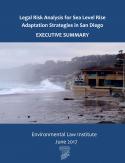
Research Reports
ELI publishes Research Reports available for free download that present the analysis and conclusions of the policy studies ELI undertakes to improve environmental law and policy. These reports contribute to education of the profession and disseminate diverse points of view and opinions to stimulate a robust and creative exchange of ideas. Those publications, which express opinions of the authors and not necessarily those of the Institute, its Board of Directors, or funding organizations, exemplify ELI’s commitment to dialogue with all sectors.
Indoor air quality is an important part of a healthy home. Exposure to indoor pollutants – from lead-based paint and radon to mold and secondhand smoke – can affect your health. Children, older adults, and people with asthma and other medical conditions may be especially vulnerable to the harmful effects of indoor air pollutants.
Read More >
One of the greatest impacts of climate change on the Chesapeake Bay watershed will be stormwater management. The Chesapeake region is in the position to take national leadership on the issue of climate change impacts to our vulnerable coastal communities. Rather than resorting to retreat, or relying on conventional stormwater strategies already proving ineffective, the people of Maryland and Virginia have an opportunity to demonstrate their resiliency in the face of change.
Read More >
Adapting to sea level rise raises significant legal questions for local governments, especially in California. On the one hand, taking action could decrease risk to the community, but increase litigation risk from aggrieved property owners or public interest groups, depending on the nature of the action. On the other hand, a local government could decide not to act, exposing people and infrastructure to excess risk, while potentially exposing itself to litigation if the lack of action causes harm to individuals or public trust property. Risk is thus unavoidable.
Read More >
Sea level rise raises significant legal questions for local governments, especially in California. On the one hand, taking action could decrease risk to the community, but increase litigation risk from aggrieved property owners or public interest groups, depending on the nature of the action. On the other hand, a local government could decide not to act, exposing people and infrastructure to excess risk, while potentially exposing itself to litigation if the lack of action causes harm to individuals or public trust property. Risk is thus unavoidable.
Read More >
In the coming decades, billions of dollars will go to Gulf of Mexico restoration projects through processes set up after the Deepwater Horizon (DWH) oil spill. Hundreds of projects have already been approved, and many more are on the way. As the deluge of projects begins, it’s essential to take a step back and ask a simple question: What makes for a “good” restoration project?
Read More >